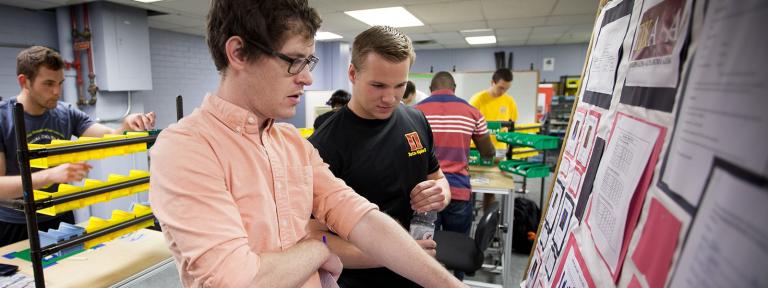
From cracked stamping parts to stunt bikes to a fence in a box, Charles White, professor of Industrial and Manufacturing Engineering, and his Failure Analysis class have seen it all, in fact, they actively seek "it" out.
"Someone conceptualizes, designs and builds something and it fails - why?" In what White dubs "Reverse Engineering" or "Backward Design," students test broken mechanical devices to determine why they failed (broke). Some of the parts come from the students' co-op employers, some from friends or local businesses and sometimes former students of White will send projects from their current employers.
If students don't bring in their own project they are assigned one from the "cadaver" cart, a rolling cart piled high with broken machines or pieces of machines.
They begin their analysis by photographing the parts to document their project from start to finish, according to American Society of Testing Materials (ASTM) guidelines. "It's a little stricter than what they would do in a plant setting," said White, but with their final project there is more emphasis on them (the students) dealing with the client, someone who really wants an answer, and not just their professor," he said.
"In this class the students can take all their knowledge and apply it in a class environment, try out ideas and make mistakes," said White, "this is real engineering. The kids don't know you can't do it this way, so they come at it from a whole new perspective." The Material Analysis classes do about 25 projects a year, according to White.
"No money is exchanged," said White, "we're just looking for the projects for the students to work on." But if the project requires commercial lab work done then the company requesting the analysis pays for the lab fees.
"A lot of projects come from students going back to their co-op employers and asking for projects," White said. The only restriction White puts on potential projects is that they can't currently be in litigation or need an immediate answer.
Some of the more interesting projects have included: Fence in a Box - a project that came to White from a local business, Genova, that produces a do-it-yourself vinyl fence kit. "Some of the panels were breaking during assembly and they wanted to know why," said White. "We did a cold and hot temperature test, bent it to test the tensile strength and ran over it with a truck. The students did a report on their findings and made suggestions on assembly and spacing of the fence slats. Genova said it was the best report they had ever seen," White said. The company wanted to reward the students for their work, but White refused to take payment. He suggested to Bob Hunt, plant manager for Genova, that college students are always hungry and short on cash, so Hunt gave each of the students involved in the project a gift certificate to a local restaurant.
Shell Casings: Another project involved studying shell casings for the U.S. Coast Guard. Standard 76mm guns used shells with a rolled casing that would get stuck in the gun. White and his students spent four months studying the failure and found that a clamp in the bottom of the shell was not working properly allowing the sheet metal to unwrap and causing the shell to stick.
Other projects range from a farmer with a bad combine piston rebuild to a powertrain problem at Harley Davidson to a stunt unicycle that had been ridden off the roof of a building.
White would love for more alumni to send projects his way, and maybe come talk to a class about their work. "We need them to share their knowledge with students," he said. "All I want is a better project for the kids to work on, something challenging. I like doing this work, it's a lot of fun," he said.
Written by Dawn Hibbard
810-762-9865
dhibbard@kettering.edu